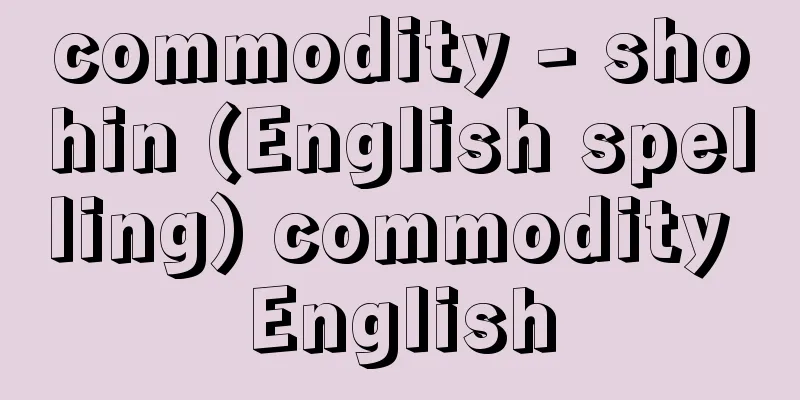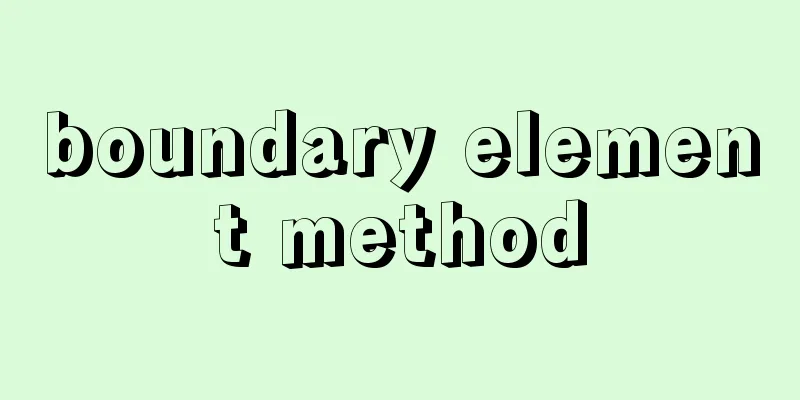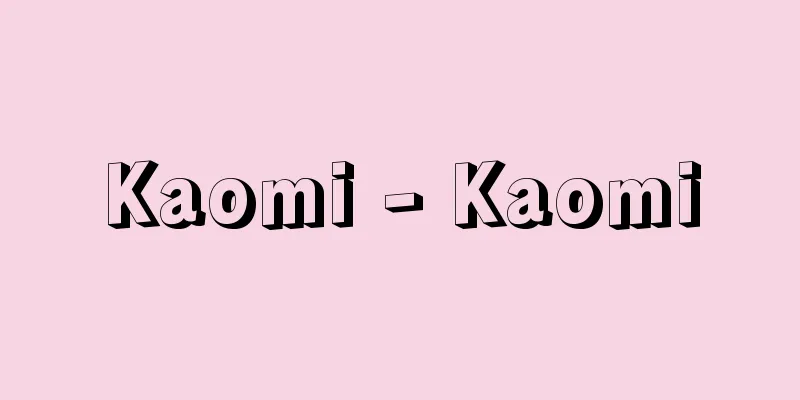commodity - shohin (English spelling) commodity English

Economic GoodsCommodities are the form that products of labor, which are the objects of desire produced in material production, take on only when they are in an exchange relationship. Certain social and historical conditions are necessary for this form to take place. These conditions are the existence of a social division of labor and the private and decentralized ownership of the means of production. In other words, under a social division of labor, the types of labor products one can produce are limited, so one must use the labor products of others. Furthermore, under private and decentralized ownership, which is opposed to social ownership, one can only obtain the labor products of others by providing one's own labor products. Therefore, under these conditions, one can only obtain the labor products of others through exchange. [Kaido Katsutoshi] Product ValueThus, on the one hand, commodities are products of labor and have utility in satisfying certain desires, and on the other hand, they are exchanged; that is, they have exchange value. As objects of desire satisfaction, the physical, chemical, and geometrical properties and shapes that make up each type of commodity are different, and these differences are their use values. However, commodities are exchanged in a way that is clearly distinct from them. In order to be exchanged for one another, there must be something in common between commodities. This commonality is not the form or the various physical, chemical, and geometrical properties that distinguish each commodity, that is, their use values. If we remove these, then the only thing that is common to them is the social aspect of being the products of human labor. This product of human labor does not mean the product of the concrete useful labor that produces each commodity. The unit of measure is the general, undifferentiated human labor that has lost its concrete, useful aspect; abstract human labor as a general productive expenditure of the mental and physical labor capacities of humans that is qualitatively common and can only be compared quantitatively; and therefore simple labor that any ordinary human being can perform. Abstract human labor is converted into this in the social process; this is the common social substance of commodities, and on this basis, commodities are compared. The abstract human labor that is objectified and crystallized in a commodity is called the value of the commodity. The exchange value mentioned above is the form in which this value appears. In this case, abstract human labor is the substance of value. And since the quantity of value of a commodity is the quantity of the previous labor that has crystallized in it, it is measured by the duration of labor. This labor time is not determined by the individual product, but by the socially necessary labor time, that is, the labor time necessary to produce it under the normal production conditions of society at any given time and with the socially average skill and intensity of labor. This is because value is social. On the one hand, the commodity as a whole is a use value that satisfies human desires, and on the other hand, the commodity as a whole is a value that is the crystallization of abstract human labor. In other words, the commodity is a unified entity that contains within it the two factors of use value and value. These two factors stem from the dual nature of the labor that produces goods. On the one hand, labor is productive activity that is suited to specific ends, modes of operation, objects, and means, and produces specific use values. This is called concrete useful labor. Therefore, each concrete useful labor is different, and each one has a different use value. Use values originate from this concrete useful labor and natural materials. On the other hand, labor is the expenditure of human labor power in the physiological sense, such as the brain, muscles, nerves, and hands, regardless of the form of expenditure. This is called abstract human labor, and it is this equivalent human labor or abstract human labor that creates value. [Kaido Katsutoshi] Value in exchangeHowever, in the exchange of commodities, which is the form of exchange of products, the two factors of a commodity, use value and value, are in contradiction with each other. The commodity owner offers his commodity for exchange because the commodity he owns has no use value and is not consumed. The use value of the commodity is its use value for others, but to the commodity owner, its use value is merely a bearer of exchange value. It has a use value as a medium of exchange. All commodities are non-use values to their owners and use values to non-owners, so it is a total exchange. However, since exchange is related as value, they must demonstrate their reality as value before they can be realized as use values. On the other hand, before a commodity can be realized as a value, it must demonstrate its use-value quality, for, since only things that have use-values can be exchanged, the human labour expended in it must be expended in a form that is useful to others, and whether or not something is useful to others is only confirmed by the exchange of the commodity. In this way, the two factors of a commodity, use value and value, presuppose each other and mutually exclude each other. To the owner of a commodity, it is a use value for others that has value. Furthermore, a commodity only becomes useful as a use value when it is exchanged for another commodity, realizing its equal value with other commodities. However, once exchanged, it is no longer a commodity, but merely a use value for the buyer. Commodities are transitional. Commodities are the simplest of the contradictions in economic relations that take the form of exchange. However, capitalist society exists as a relationship in which this exchange relation is repeated on a daily basis, on a mass scale, in billions of different ways. For this reason, the commodity form develops into the money form and the capital form, thereby unravelling all the contradictions in capitalism. Therefore, commodities are precisely the economic cellular form, just like the smallest unit of cells that constitute and unravel an organism. Under capitalism, commodities extend to things that are not labor power, which is an attribute of the human body, or products of labor (such as land and honor), and in the case of interest-bearing capital, capital is even simulated as a "commodity." [Kaido Katsutoshi] Commodity science productsAccording to the traditional view of commodities, economic goods, which are "commodities in the broad sense," are divided into tangible and intangible goods; tangible goods are further divided into movable and immovable goods, and movable goods are divided into real and formal goods; however, real goods are called "commodities in the narrow sense" and are commodities in the ordinary physical sense. In commodity theory, a commodity is defined as a physical commodity that (1) has real value that can satisfy a person's material desires, (2) can be transferred from one ownership to another through exchange with currency and can be moved at the same time through transportation and storage, (3) is produced in anticipation of the market, and (4) is actually and directly placed in a commercial environment or distribution process and is subject to commercial handling. This refers to tangible movable property that has some real value and is actually placed in a commercial environment. Therefore, custom-made products and products that have real value but are not intended as objects of trade that have a use value themselves, such as antiques, do not fall into this category. [Hiroaki Aoki and Hideo Otake] Product classificationSince there are an infinite number of different products circulating in the market, it is necessary to establish certain standards for classifying and organizing them. There are various classification standards, but the most commonly used are (1) classification by the physical or chemical properties of the product, (2) classification by the mode of production or source of production of the product, (3) classification by the mode of consumption or use of the product, and (4) classification by the mode of distribution of the product. In the classification of (1), there is a distinction between non-durable products (such as fresh produce) and durable goods based on whether they are prone to spoilage or not, between quantity and ad valorem goods based on the degree of value concentration, and between liquid, gas, solid, powder, viscous, granular goods, etc. based on the properties of the unit form. Of these, quantity goods are those that have a low value intensity compared to their weight or volume, such as cotton, steel, and rice, while ad valorem goods are those that have a high value intensity and whose weight and volume are not an issue, such as jewelry and precision instruments. In the classification of (2), products are divided into agricultural products, fishery products, forest products, mineral products, and industrial products according to the type of industry, and industrial products are further classified into brewing products, textile products, chemical products, machinery products, electronic products, ceramic products, etc. Also, according to the degree of processing, they are divided into raw materials (crude products), semi-finished products (also called semi-finished products, or work in progress), and finished products (refined products). Classification (3) is the most widely used classification, and is based on whether the product is used for productive (industrial) consumption or for final consumption by consumers. Products used for productive consumption are called producer goods, which are further divided into raw materials, materials, parts, accessories, equipment, etc. Of these, raw materials are chemically processed, and materials are physically (mechanically) processed to become new goods. This classification is a term that has been used based on the concept of production versus consumption, and products used by service providers and government agencies that are not involved in the production of concrete goods are producer goods, even if they are final consumer goods, and are often called industrial goods. They are also classified into genuine products (genuine), counterfeit products, fake products, imitations, and artificial products according to their authenticity and mixture. Counterfeit products are products that are a mixture of similar products, such as butter and margarine blends, and woven or interwoven fibers. However, in modern times, labeling systems such as the Household Products Quality Labeling Act, the JAS Act (Act on Standardization and Proper Labeling of Agricultural and Forestry Products), and the Food Sanitation Act force the labeling of all products, so there are fewer cases of falsifying the names of ingredients, and instead, products are used to brand by simply listing the exact condition of the product, such as the ingredients and their ratios. For example, margarine brands often include the names of ingredients and their ratios, such as corn oil as the main ingredient, blended with half butter, using safflower oil, and containing fermented butter. In addition, in the case of summer clothing that emphasizes the cool texture of the material, it is common to see products that advertise "linen and cotton blend" as a sales promotion in addition to the composition. In this way, many modern clothing products use multiple materials to produce highly suitable products, such as those that have the functions required for the assumed environment of use, and explain the functions of those materials. Therefore, the use of multiple materials does not mean that the product is of poor quality, but during the period after World War II when raw materials were in short supply, many poor quality products that used multiple materials were sold as genuine products. In the case of food, even today, qualitative adulteration of the appearance due to food additives is seen in many products. Examples of weight-increasing falsehood include thickening the ice layer (called glaze) on the surface of frozen peeled shrimp used to dry and prevent oxidation, and adding water to white sugar to increase the weight (note that the weight of peeled shrimp is listed excluding the glaze according to the Measurement Act). Counterfeit products are products that are imitations or counterfeit products that are falsely labeled as genuine products, and are manufactured and processed with the aim of deceiving consumers. Falsified brands and origins are also a type of this. Commodities that are destined for final consumption are called consumer goods, which are further classified into necessities and luxuries, consumables and durables, and, depending on their use, into food, clothing, housing goods, and cultural and entertainment goods. In the classification of (4), products are classified according to the purchasing habits of consumers into local products, shopping-around products, specialty products, standardized products and special design products, labeled products and unlabeled products (no-brand products), frozen products, refrigerated products, and room temperature products. Local products are products that consumers can purchase at the nearest store, while shopping-around products are products that consumers visit various stores to compare quality, price, design, etc. before making a purchase. Specialty products refer to luxury goods and durable goods purchased at specialized stores. The above commodity classifications are standard, and when considering issues such as distribution and store management, a different classification system that combines several classification standards is often used. Commodity classification is also essential for compiling commodity statistical tables, imposing customs duties, and trade transactions, and for this reason, various classification systems are used, such as the Japanese Standard Commodity Classification, which was created to classify all traded commodities, and the Harmonized Commodity Description and Coding System (abbreviated as HS), which was established as the HS Treaty to unify the tariff schedules of each country and facilitate international trade. [Hiroaki Aoki and Hideo Otake] Product sales and distribution channelsWhen buying and selling goods, an agreement must be made regarding the quality, type, quantity, price, place of delivery, time of delivery, payment method, etc. These are called the terms of sale of the goods. The quality of a product can be determined by a variety of methods, such as actual product, sample, brand, standard product, and specification, depending on the product. A brand is a name that is customarily and widely accepted as an indication of the quality of a particular product, and can be expressed by the place of origin, grade, standard, trademark, trade name, etc. With the standard product method, the seller and buyer decide in advance on a standard quality item, and the product is bought and sold based on this standard. Regarding the quantity of a commodity, the standards used differ depending on the type of commodity, and the buying and selling units also usually differ depending on the distribution stage. The price of a product is displayed based on a certain quantity called the base price, and this price is called the base price. The price varies depending on how freight, insurance, storage fees, etc. are paid. The time of delivery can be immediate, direct, or deferred. Payment methods include cash payment, deferred payment (payment on credit, bill payment, installment payment, etc.), and advance payment. In domestic transactions, a fixed price system was used in which the manufacturer decided the manufacturer's suggested retail price incorporating the margin at the distribution stage, but the fixed price system could not be maintained and cheap sales became the norm. In addition, the Fair Trade Commission pointed out the possibility of violating the double price display in the Unfair Premiums and Misrepresentations Prevention Act, and an increasing number of products are now subject to an open price system. Note that fixed prices in trade transactions include FOB price (shipped on board) and CIF price (shipped including freight and insurance). [Hiroaki Aoki and Hideo Otake] Products, resources and environmental issuesUntil the 1970s, goods were considered to be within the scope of economic activities from production to consumption. However, in the face of global-scale environmental destruction and resource problems, and because the Earth has become relatively small due to the expansion of human economic activity and population growth, people's view of the Earth has changed from one with self-purifying capabilities and infinity to one that is finite. Therefore, since the 1970s, product development, distribution, and disposal have come to be viewed as being based on resource and environmental issues, and in order to restore the Earth's original form and leave it for future generations, people have revised their economic activities with the proposition of production and consumption activities that have a low burden on resources and the environment and a circular economic system. In the production, distribution, and consumption of goods, products and their manufacturing and packaging that reduce waste generation have been realized, packaging and main bodies are reused, and even recycled (Recycle) and reused through material recycling, or thermal recycling that converts them into energy, etc. are being carried out. Recycling, which is called venous circulation to circulate resources, requires waste collection processes, regeneration processing, and recycled resource distribution processes. However, unless the use of recycled materials is made mandatory, recycled materials will not be distributed unless they are priced at the same price or lower than virgin materials. Therefore, even in the case of recycling, the cost of consumer life cannot be reduced unless production efficiency is improved. At the same time, the development of methods that can reduce recycling costs at the time of product planning and design is required. Therefore, the suitability of a product does not only mean the suitability of the product when it is consumed and used and its suitability for the market, as has been considered up to now, but also includes "social suitability" such as low burden on resources and the environment and suitability for recycling, and it is assumed that these are incorporated in the process of product formation, including individual packaging. In 1991 (Heisei 3), the "Act on Promotion of Utilization of Recycled Resources" (commonly known as the "Recycling Act") was enacted for the purpose of creating a recycling-oriented society, and in 2000 (Heisei 12), it was revised to the current "Act on Promotion of Effective Utilization of Resources" (enacted in 2001). At the same time, the basic framework for a recycling-based society was established by the Fundamental Law for Promoting the Creation of a Recycling-Based Society (enacted in 2000), and the Container and Packaging Recycling Law (enacted in 1995), Home Appliance Recycling Law (enacted in 1998), Food Recycling Law, Construction Recycling Law (enacted in 2000), and Automobile Recycling Law (enacted in 2002) were revised or enacted, and the Law Concerning Special Measures for Countermeasures against Dioxins was enacted in 1999. Based on this approach, not only are metals, plastics, paper, glass, and food recycled, but rare metals, including rare earths, which are scarce resources, are also recycled. In large cities, the term "urban mines" is used because of the large amount of resources recovered from electronic devices and other sources. In the case of rare metals, recycling has begun to function in the direction of lowering international trading prices, helping to secure resources for major cutting-edge industries. [Hideo Ohtake] [Reference items] | | | | | | | | | | |Source: Shogakukan Encyclopedia Nipponica About Encyclopedia Nipponica Information | Legend |
経済学上の商品商品とは、本来物質的生産において生産された欲望の対象である労働生産物が、交換関係にある場合に初めてとる形態である。この形態をとるには、一定の社会的・歴史的条件が必要である。その条件とは、社会的分業の存在と生産手段が私的・分散的に所有されていることである。すなわち、社会的分業のもとでは、自分が生産する労働生産物の種類は制限されるから、他人の労働生産物を利用しなければならない。また、社会的所有に対立する私的・分散的所有のもとでは、自己所有の労働生産物を提供してしか他人所有のものを手に入れられない。したがって、この条件のもとでは、交換を通じてしか他人所有の労働生産物を入手しえないことになる。 [海道勝稔] 商品の価値このように商品は、一方で労働生産物としてなんらかの欲望を充足させる有用性をもつとともに、他方では交換されるものである。すなわち、交換価値をもつ。欲望充足の対象としては、商品ごとにその種類を構成する物理的・化学的・幾何学的性質や形状の違いとなるが、この違いは使用価値である。ところが、これと明確に区別されるものとして商品は交換されるものとしてある。互いに交換されるには、商品どうしの間に一定の共通なものがなければならない。この共通なものとは、それぞれの商品を区別している形状や物理的・化学的・幾何学的性質の諸属性、つまり使用価値ではない。そこでこれらを取り去ってみると、共通なものは互いに人間労働の生産物だという社会的面のみである。この人間労働の生産物というのは、それぞれの商品を生産するそれぞれの具体的有用労働の生産物ということではない。具体的有用な面を消失した無区別な一般的人間労働、質的に共通で量的にのみ比較される人間の精神的・肉体的労働能力の生産的支出一般としての抽象的人間労働、したがって普通の人間ならだれしも行える単純労働を尺度単位とし、複雑労働は社会的過程においてこれに換算される抽象的人間労働、これが商品どうしの共通な社会的実体をなし、それに基づいて商品どうしが比較される。このように抽象的人間労働が商品に対象化され結晶しているものを商品の価値という。先の交換価値はこの価値の現象形態である。この場合、抽象的人間労働は価値の実体である。そして商品の価値量はそのなかに結晶している先の労働の量であるから、それは労働の時間的継続で計られる。この労働時間は、生産物における個別的なものでなく、社会的に必要な労働時間、つまり社会のその時々の正常な生産条件と社会的に平均的な労働の熟練と強度で生産するのに必要な労働時間によって決まるのである。これは価値が社会的なものだからである。 商品はこのように、一面では商品全体が人間の欲望を満たす使用価値であり、他面では商品全体が抽象的人間労働の結晶としての価値である。すなわち、商品はそのなかに使用価値と価値の2要因をもった統一物である。 この2要因は、商品を生産する労働そのものの二重性に起因する。労働は、一面では、特定の目的・作業様式・対象・手段にかなった生産的活動であり、特定の使用価値を生む。これを具体的有用労働という。したがって具体的有用労働は個々に異なり、個々的に使用価値は違ったものとなる。使用価値はこの具体的有用労働と自然素材を源泉とする。他面では、労働はその支出の形態にかかわりのない生理学的意味での脳髄(のうずい)・筋肉・神経・手などの人間の労働力の支出である。これを抽象的人間労働といい、この同等な人間労働または抽象的人間労働が価値を形成するのである。 [海道勝稔] 交換における価値ところが、生産物の交換形態である商品の交換において、この商品の2要因である使用価値と価値とは相矛盾しあう。 商品所有者は、彼には自己所有の商品が自己の使用価値をもたず、消費しないから交換に提供しようとする。商品の使用価値は他人のための使用価値であり、商品所有者にはその使用価値は交換価値の担い手にすぎない。交換手段という使用価値をもつことになる。すべての商品は、その所有者には非使用価値であり、非所有者には使用価値であるから、全面的交換となるのである。しかし、交換は価値として連関することであるから、使用価値として実現する前に価値としての実を示さなければならない。 他方、商品は価値として実現する前に使用価値たる実を示さなければならない。なぜなら、使用価値あるものしか交換されないから、そこに支出された人間労働は、他人にとって有用な形態で支出されていなければならない。ところが、他人に有用か否かは、商品の交換のみが証明するからである。 このように商品の2要因である使用価値と価値は、相互に前提しあうとともに相互に排除しあう。商品の所有者には価値を有する他人のための使用価値である。さらに商品は、他の商品と交換されて初めて価値として他の商品との同等性が実現され、使用価値として役だつものとなるが、しかし交換されてしまえばもはや商品でなく、買い手にとっての単なる使用価値になってしまう。商品は経過的なものである。 商品は、交換の形態をとる経済関係の矛盾のもっとも簡単なものである。ところが、資本主義社会は、この交換関係が日常的で大量に幾十億通りにも繰り返される関係として存在する。そのことから、商品形態は貨幣形態・資本形態へと運動を展開して資本主義の全矛盾を解き明かすことになるから、商品は、有機体を構成し、かつそれを解明する最小単位の細胞と同じく、まさに経済上の細胞形態である。 商品は、資本主義のもとでは、人間の肉体の属性である労働力や労働生産物でないもの(たとえば土地・名誉など)にまで及び、さらに利子生み資本においては資本を「商品」として擬似化さえするに至る。 [海道勝稔] 商品学上の商品伝統的商品観による「広義の商品」である経済財は有形・無形財に分けられ、さらに有形財は可動・不動財、可動財は実質・形式財に分けられるが、この実質財は「狭義の商品」と称され、通常のモノとしての商品である。 商品学上の商品は、このモノとしての商品を(1)人間の物質的欲望を満たしうる実質的価値を有するもの、(2)通貨を用いての交換により所有を一方から他方へ転換でき、同時に運送や保管の機能により移動しうるもの、(3)市場を対象に見込み生産されているもの、(4)そのものが現実かつ直接に商環境や流通過程に置かれ、商的取扱いを受けているもの、としている。これは、何らかの実質的価値を有する有体動産のうち、現に商いの環境に置かれているものである。したがって注文生産品や、実質的価値をもっていても骨董品(こっとうひん)などのような使用価値そのものを目的としない取引対象物としての商品はこの範疇(はんちゅう)に入らない。 [青木弘明・大竹英雄] 商品の分類市場に流通する商品は多種多様なものが数限りなく存在するので一定の基準を設けて分類・整理する必要がある。分類基準自体にも種々あるが、一般に用いられているのは、(1)商品の物理的もしくは化学的性質による分類、(2)商品の生産様式もしくは産出源による分類、(3)商品の消費様式もしくは用途による分類、(4)商品の流通様式による分類などである。 (1)の分類では、腐敗損傷性の有無による非耐久製品(生鮮商品など)と耐久性商品、価値集中の程度による従量品と従価品、単位形態の性状によって液体、気体、固体、粉体、粘体、粒状商品などの区別がある。これらのうち従量品とは、綿花、鉄鋼、米穀など重量・容積に比して価値集約度が低いものをいい、従価品とは宝石、精密機器のように価値集約度が高く、重量や容積は問題にならないものをいう。 (2)の分類では、産業の業態によって農産品、水産品、林産品、鉱産品、工産品に分け、工産品はさらに醸造工業品、繊維工業品、化学工業品、機械工業品、電子工業品、窯業品などに細分類される。また、加工度の精粗によって原料(粗製品)、半成品(半製品ともいう。仕掛品)、完成品(精製品)に分けられる。 (3)の分類は、商品が生産(産業)的消費に充当されるか、消費者による最終的消費に充当されるかによる区分であり、もっとも広く用いられる分類である。生産的消費に充当される商品は生産財とよばれ、これはさらに原料品、材料品、部分品、補助品、設備品などに分けられる。このうち原料品は化学的加工が、材料品は物理的(機械的)加工が施されて新しい財になるものをいう。この分類は生産対消費という概念から使われてきたことばであり、具体的なモノの生産活動ではない各種サービスの事業者や官公庁が使う商品は、最終消費財のような商品であっても生産財であり、これを産業財とよぶことも多い。 また真偽や混合などによって真正品(しんせいひん)(本物)、偽交品、偽称品、模造品、人工品などに分けられる。偽交品は似たものを混合したもので、バターとマーガリンのブレンド、繊維の混紡や交織などがある。しかし現代では家庭用品品質表示法、JAS法(農林物資の規格化及び品質表示の適正化に関する法律)、食品衛生法などの表示制度があらゆる商品の表示を強制しているため、原材料名を偽る事例は少なくなり、原材料やその割合など、商品の正確な状態をそのままうたうことで、かえってブランド化に利用している。たとえばマーガリン類のブランド名では、コーン油を主原料とすること、ブレンドしているバターが半分であること、サフラワー油(べにばな油)を使用していること、発酵バターを含むことなど、それぞれ原料名やその割合を組み込む事例も多い。また涼しい素材感を打ち出す夏物の被服の場合、組成表示以外に販売促進として「麻綿混」などとうたっているものも普通にみられる。このように現代では、想定された使用環境において必要とされる機能をもたせるなど、適合性の高いものを製造するために複数の素材を使い、その機能を説明している被服品も多い。したがって複数素材を混用していても粗悪品を意味しないが、第二次世界大戦後の原料が不足していた時期には、複数素材を混用した粗悪品が、本物と偽って販売された事例が多かった。食品の場合、現代でも食品添加物による見た目の質的な偽交は多くの商品にみられる。また増量偽交では、冷凍むきエビの乾燥や酸化防止のために使用される表面の氷の膜(グレーズglazeという)を厚くしたもの、上白糖へ水分を含ませて増量したものなどの事例がある(なお、むきエビの表示重量は計量法によってグレーズを除いたものとされている)。偽称品は模造品や偽交品を真正品と偽った商品で、消費者を欺瞞(ぎまん)する目的で製造加工を施すものであり、ブランドや産地を偽ったものもこの一種である。 最終的消費に充当される商品は消費財とよばれ、これはさらに必需品と奢侈品(しゃしひん)、消耗品と耐久品、用途によって食料品、衣料品、住宅品、教養・娯楽品など多様に分類される。 (4)の分類では、需要者の購買慣習によって最寄品(もよりひん)、買回り品、専門品、規格品と特別意匠品、有標品と無標品(ノーブランド商品)、冷凍品・冷蔵品・常温品などに分類される。最寄品は需要者がもっとも近い店で適宜入手するもの、買回り品は購買に際して各店を回り、品質、価格、デザインなどを比較選択する商品をいう。また専門品は、専門的に取り扱う店で購入する高級品、耐久品などをさしている。 以上の商品分類は標準的なもので、流通や商店経営などの問題を考える場合には、いくつかの分類基準を混合した別な分類方式がとられることが多い。また商品分類は商品統計表の作成、関税の課税、貿易取引などに不可欠であり、このため取引されるすべての商品を分類するために作成された日本標準商品分類や、各国の関税率表を統一し、国際貿易の円滑化のためにHS条約として制定された国際統一商品分類(Harmonized Commodity Description and Coding System。HSと略す)などが利用されている。 [青木弘明・大竹英雄] 商品の売買・流通経路商品の売買にあたっては、商品の品質、種類、数量、価格、引渡し場所、引渡し時期、代金決済方法などについて契約しなければならない。これらを商品の売買条件という。 商品の品質を決める方法としては、現品、見本、銘柄、標準品、仕様書など商品に応じた方法がとられる。銘柄とは、特定商品の品質を表示するものとして慣習上広く認められている名称で、産地名、等級、規格、商標、商号などで表される。標準品による方法は、あらかじめ売り手と買い手が品質の標準的なものを定めておき、これを基準として売買する。 商品の数量については、商品の種類に応じて用いる基準が異なり、流通段階によっても、また売買単位が異なるのが普通である。 商品の価格は、建(たて)とよばれる一定の数量を基準にして表示され、この価格を建値といい、運賃、保険料、保管料などの負担方法によって価格が異なる。 引渡しの時期にも、即時渡し、直(じき)渡し、延(のべ)渡しの別がある。 代金決済の方法には、現金払い、後(あと)払い(掛(かけ)払い、手形払い、賦(ふ)払いなど)、前払いなどの別がある。国内取引ではメーカーが流通段階のマージン(利幅)を組み込んだメーカー希望小売価格を決める建値制がとられていたが、建値制を維持できずに安売りが常態化したこと、加えて公正取引委員会により「不当景品類及び不当表示防止法」の二重価格表示に抵触する可能性を指摘され、オープン価格制がとられる商品も増えている。なお貿易取引の建値にはFOB価格(本船渡し価格)、CIF価格(運賃保険料込み渡し価格)などがある。 [青木弘明・大竹英雄] 商品と資源・環境問題1970年代まで、商品はその生産から消費までの経済活動の範囲でとらえられてきた。しかし、地球規模の環境破壊や資源問題に直面し、また人類の経済活動の規模拡大や人口増加などによって相対的に地球が矮小(わいしょう)化したため、人々の地球観は自浄能力や無限性を有する地球から有限な地球へと変化した。したがって1970年代以降、商品の開発や流通および廃棄は資源・環境問題を前提にしてとらえられるようになり、地球本来の姿を取り戻して後世に残すために、人々は、資源・環境に対し低負荷性をもつ生産・消費活動と循環型の経済システムを命題として経済活動を修正してきた。商品の生産・流通・消費の際に、ごみの発生を抑制(リデュースReduce)させる商品およびその製造と包装の実現や、包装や本体を再使用(リユースReuse)し、さらには再資源化(リサイクルRecycle)してマテリアルリサイクルによる再生利用や、エネルギーなどに変換するサーマルリサイクルが行われている。資源を循環させるための静脈流通とよばれるリサイクリングには、廃棄物収集過程、再生加工、再生資源流通過程などが必要となった。しかしリサイクルによる再生原料の使用が強制されなければ、再生原料はバージン原料価格と同価格またはそれ以下でなければ流通しない。したがってリサイクルにおいても、生産の効率性を高めなければ消費生活のコストを低下させることができない。同時に商品の企画や設計の時点において低リサイクルコストですむ方法の開発が要求される。よって商品の適性には、これまで考えられてきた商品の消費・使用の際の使用適性や市場に対する適性だけでなく、資源・環境に対する低負荷性やリサイクル適性などの「社会(適)性」も含まれ、個装を含む商品形成の過程でこれらを組み込むことが前提となっている。1991年(平成3)には循環型社会のために「再生資源の利用の促進に関する法律」(通称「リサイクル法」)が制定され、2000年(平成12)に現行の「資源の有効な利用の促進に関する法律」に改正された(2001年施行)。また同時に循環型社会の基本的枠組みを「循環型社会形成推進基本法」(2000年制定)によって定め、「容器包装リサイクル法」(1995年制定)、「家電リサイクル法」(1998年制定)、「食品リサイクル法」「建設リサイクル法」(2000年制定)、「自動車リサイクル法」(2002年制定)などが改正あるいは制定され、1999年には「ダイオキシン類対策特別措置法」も制定されている。このような考え方から、金属、プラスチック、紙、ガラス、食品のリサイクルはもとより、希少資源であるレア・アース(希土類元素)を含むレアメタル(希金属)のリサイクルも行われている。大都市では電子機器などからの資源回収量が多いことから、「都市鉱山」ということばも使われている。レアメタルの場合、リサイクルが国際取引価格を低下させる方向で機能し始めており、主要先端産業の資源確保に役だっている。 [大竹英雄] [参照項目] | | | | | | | | | | |出典 小学館 日本大百科全書(ニッポニカ)日本大百科全書(ニッポニカ)について 情報 | 凡例 |
>>: Trademark - shouhyo (English) trade mark
Recommend
ALARA - Alara
" as low as reasonably achievable " is a...
Banba Post Station
A post station in Sakata County, Omi Province. It ...
Eyespot - Ganten
It is found in the protozoan flagellates, lower i...
Manu
…Silver was measured in the form of grains, bars,...
Lufthansa German Airlines [company] - Lufthansa Germany Airlines (English name) Deutsche Lufthansa AG
German airline. Airline code: LH. Headquarters: Co...
Pulse - Myakuhaku (English spelling) pulse
It is also simply called the pulse. It is a wave c...
Barnard's star
A red star with a visual magnitude of 9.5 in the ...
Oobora Shell Mound
A shell mound from the late Jomon period is locat...
Atractylodes lancea (English spelling)
…[Nitta Aya]. . . *Some of the terminology that m...
Laurana
Italian sculptor and architect. He was active not ...
Nagoya University
[Kunitachi, Chikusa Ward, Nagoya City, Aichi Prefe...
Hendrix, J.
…In the mid-1960s, psychedelic music emerged on t...
Conjunctival xerosis
...Therefore, loss of this function can lead to s...
Awan Kingdom - Awan Kingdom
...Recent archaeological research has demonstrate...
destuff jitter
…In digital communications, jitter is caused by t...







![Tsukiyono [town] - Tsukiyono](/upload/images/67cc3b4b0f0b2.webp)

